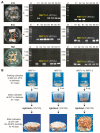Effects of MAT1-2 Spore Ratios on Fruiting Body Formation and Degeneration in the Heterothallic Fungus Cordyceps militaris
- PMID: 37888227
- PMCID: PMC10607669
- DOI: 10.3390/jof9100971
Effects of MAT1-2 Spore Ratios on Fruiting Body Formation and Degeneration in the Heterothallic Fungus Cordyceps militaris
Abstract
The medicinal mushroom Cordyceps militaris is widely exploited in traditional medicine and nutraceuticals in Asian countries. However, fruiting body production in C. militaris is facing degeneration through cultivation batches, and the molecular mechanism of this phenomenon remains unclear. This study showed that fruiting body formation in three different C. militaris strains, namely G12, B12, and HQ1, severely declined after three successive culturing generations using the spore isolation method. PCR analyses revealed that these strains exist as heterokaryons and possess both the mating-type loci, MAT1-1 and MAT1-2. Further, monokaryotic isolates carrying MAT1-1 or MAT1-2 were successfully separated from the fruiting bodies of all three heterokaryotic strains. A spore combination of the MAT1-1 monokaryotic isolate and the MAT1-2 monokaryotic isolate promoted fruiting body formation, while the single monokaryotic isolates could not do that themselves. Notably, we found that changes in ratios of the MAT1-2 spores strongly influenced fruiting body formation in these strains. When the ratios of the MAT1-2 spores increased to more than 15 times compared to the MAT1-1 spores, the fruiting body formation decreased sharply. In contrast, when MAT1-1 spores were increased proportionally, fruiting body formation was only slightly reduced. Our study also proposes a new solution to mitigate the degeneration in the heterokaryotic C. militaris strains caused by successive culturing generations.
Keywords: Cordyceps militaris; degeneration; fruiting body formation; heterokaryotic strains; heterothallic fungus; mating-type loci; sexual reproduction; spore ratios; successive culturing generations.
Conflict of interest statement
The authors declare no conflict of interest. The funder had no role in the design of the study; in the collection, analyses, or interpretation of data; in the writing of the manuscript; or in the decision to publish the results.
Figures




Similar articles
-
Effects of mating-type ratio imbalance on the degeneration of Cordyceps militaris subculture and preventative measures.PeerJ. 2024 Jul 9;12:e17648. doi: 10.7717/peerj.17648. eCollection 2024. PeerJ. 2024. PMID: 39006009 Free PMC article.
-
Ethanolic extract from fruiting bodies of Cordyceps militaris HL8 exhibits cytotoxic activities against cancer cells, skin pathogenic yeasts, and postharvest pathogen Penicillium digitatum.Arch Microbiol. 2024 Feb 13;206(3):97. doi: 10.1007/s00203-024-03833-8. Arch Microbiol. 2024. PMID: 38349544
-
Improvement of fruiting body production in Cordyceps militaris by molecular assessment.Arch Microbiol. 2013 Aug;195(8):579-85. doi: 10.1007/s00203-013-0904-8. Epub 2013 Jun 12. Arch Microbiol. 2013. PMID: 23756567
-
Advances in research on Cordyceps militaris degeneration.Appl Microbiol Biotechnol. 2019 Oct;103(19):7835-7841. doi: 10.1007/s00253-019-10074-z. Epub 2019 Aug 13. Appl Microbiol Biotechnol. 2019. PMID: 31410524 Review.
-
Biomass and Cordycepin Production by the Medicinal Mushroom Cordyceps militaris-A Review of Various Aspects and Recent Trends towards the Exploitation of a Valuable Fungus.J Fungi (Basel). 2021 Nov 19;7(11):986. doi: 10.3390/jof7110986. J Fungi (Basel). 2021. PMID: 34829273 Free PMC article. Review.
Cited by
-
Effects of mating-type ratio imbalance on the degeneration of Cordyceps militaris subculture and preventative measures.PeerJ. 2024 Jul 9;12:e17648. doi: 10.7717/peerj.17648. eCollection 2024. PeerJ. 2024. PMID: 39006009 Free PMC article.
-
Efficient generation of uridine/uracil auxotrophic mutants in homokaryotic Cordyceps militaris strains for constructing a food-grade expression platform.Mycoscience. 2024 Nov 29;66(1):45-57. doi: 10.47371/mycosci.2024.10.003. eCollection 2025. Mycoscience. 2024. PMID: 40672141 Free PMC article.
-
Discovering a novel glycosyltransferase gene CmUGT1 enhances main metabolites production of Cordyceps militaris.Front Microbiol. 2024 Oct 22;15:1437963. doi: 10.3389/fmicb.2024.1437963. eCollection 2024. Front Microbiol. 2024. PMID: 39502416 Free PMC article.
References
-
- Das G., Shin H.-S., Leyva-Gómez G., Prado-Audelo M.L.D., Cortes H., Singh Y.D., Panda M.K., Mishra A.P., Nigam M., Saklani S., et al. Cordyceps spp.: A review on its immune-stimulatory and other biological potentials. Front. Pharmacol. 2021;11:2250. doi: 10.3389/fphar.2020.602364. - DOI - PMC - PubMed
Grants and funding
LinkOut - more resources
Full Text Sources

